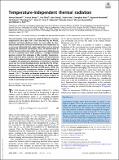Temperature-independent thermal radiation
Author(s)
Shahsafi, Alireza; Roney, Patrick; Zhou, You; Zhang, Zhen; Xiao, Yuzhe; Wan, Chenghao; Wambold, Raymond; Salman, Jad; Yu, Zhaoning; Li, Jiarui; Sadowski, Jerzy T; Comin, Riccardo; Ramanathan, Shriram; Kats, Mikhail A; ... Show more Show less
DownloadPublished version (1.240Mb)
Publisher Policy
Publisher Policy
Article is made available in accordance with the publisher's policy and may be subject to US copyright law. Please refer to the publisher's site for terms of use.
Terms of use
Metadata
Show full item recordAbstract
© 2019 National Academy of Sciences. All rights reserved. Thermal emission is the process by which all objects at nonzero temperatures emit light and is well described by the Planck, Kirchhoff, and Stefan-Boltzmann laws. For most solids, the thermally emitted power increases monotonically with temperature in a one-to-one relationship that enables applications such as infrared imaging and noncontact thermometry. Here, we demonstrated ultrathin thermal emitters that violate this one-to-one relationship via the use of samarium nickel oxide (SmNiO3), a strongly correlated quantum material that undergoes a fully reversible, temperaturedriven solid-state phase transition. The smooth and hysteresis-free nature of this unique insulator-to-metal phase transition enabled us to engineer the temperature dependence of emissivity to precisely cancel out the intrinsic blackbody profile described by the Stefan- Boltzmann law, for both heating and cooling. Our design results in temperature-independent thermally emitted power within the long-wave atmospheric transparency window (wavelengths of 8 to 14 μm), across a broad temperature range of ~30 °C, centered around ~120 °C. The ability to decouple temperature and thermal emission opens a gateway for controlling the visibility of objects to infrared cameras and, more broadly, opportunities for quantum materials in controlling heat transfer.
Date issued
2019Department
Massachusetts Institute of Technology. Department of PhysicsJournal
Proceedings of the National Academy of Sciences of the United States of America
Publisher
Proceedings of the National Academy of Sciences